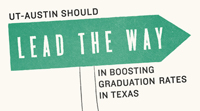Gone From Texas
Rising student debt, record numbers of applicants, flat appropriations from the state, and an economy that increasingly demands advanced degrees. These factors are behind an unprecedented, campus-wide push to get students out the door in four years.
This is the story behind that effort and an overview of the many ways the university is working to get its four-year graduation rate up to 70 percent.

In the spring of 2011, the public-policy discussion around the University of Texas could be summed up as a lot of sound and fury.
During those heady days, as the nation’s economy languished and lawmakers searched for places to cut, higher education leaders around the country felt new pressure to evaluate how efficiently they were using their resources. Around this time, we were introduced to the infamous seven breakthrough solutions, the $10,000 four-year degree, the idea that not all students needed a Cadillac-quality education (Bel-air would do), and the misbegotten notion that most UT-Austin faculty were dodgers and coasters, who would really be much more productive if only they spent their time teaching instead of doing research.
That summer, while preparing for his annual State of the University speech, UT-Austin president Bill Powers perceived that the university was trailing its peer institutions in one crucial measure of efficiency: four-year graduation rate. Powers decided he wanted to use the speech to set a big goal for the campus, and he decided that getting the four-year graduation rate up from 52 percent to 70 in five years was big and hairy enough.
He formed a task force to study the issue. The group’s 111-page report identified dozens of recommended changes, chief of which was the hiring of graduation champion David Laude. His essay in this report, “Heat and Work,” presents a chemistry-themed overview of the many efforts currently underway on the campus to enable, equip, persuade, and cajole students to get their degrees in four years.
Freshmen orientation, now mandatory, focuses incoming students on preparing a plan to graduate in four years. The way students register for classes has changed; now students closest to graduating (not necessarily those with the most hours) get priority. New efforts to improve advising, identify and address bottleneck courses, and strategically use financial aid to encourage students to graduate more quickly are all underway.
For as much agreement as there is on the issue of improving graduation rates (and there is a lot), it is not unanimous. Reasonable people can—and in these pages they do—disagree about whether 70 percent is a good goal, whether it is too high or too low, or whether it’s the right metric at all. Hillary Hart, chair of UT’s faculty council, gives the effort cautious and caveated support. Raymund Paredes, Texas’ commissioner of higher education, backs it fully. A talented student articulates why she is taking a fifth year. And philosophy professor Rob Koons makes the case that emphasizing graduation rates so heavily risks exacerbating a troubling trend in higher education toward grade inflation.
These reasoned perspectives augment our understanding of the clear and present issues in Texas higher education and at our university especially. This is not sound and fury. It was Ashbel Smith, the first chairman of UT’s Board of Regents, who said: “Smite the rocks with the rod of knowledge, and fountains of unstinted wealth will gush forth.” Now, that sounds more like it.
Below, explore 11 different perspectives on this issue—from educators and students, alumni and administrators, and more:
Top illustration by Dirk Fowler.
Thumbnail illustrations by Melissa Reese.




























No comments
Be the first one to leave a comment.